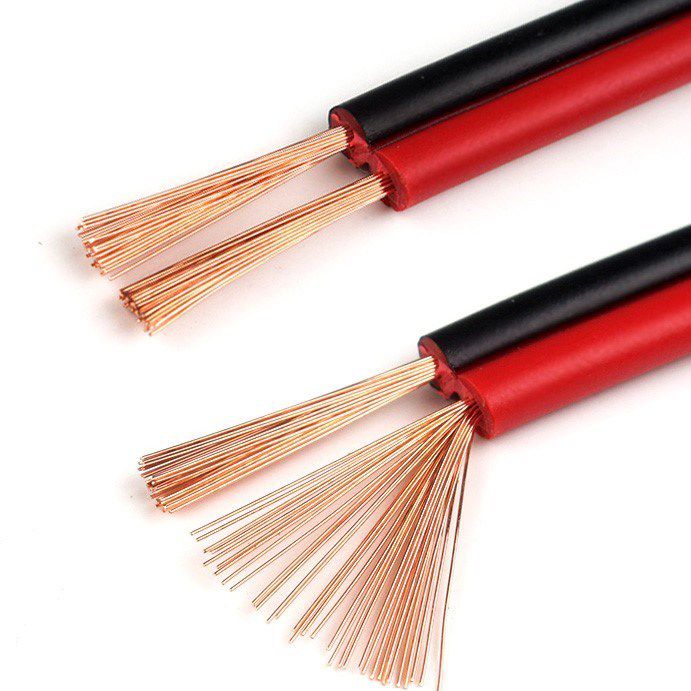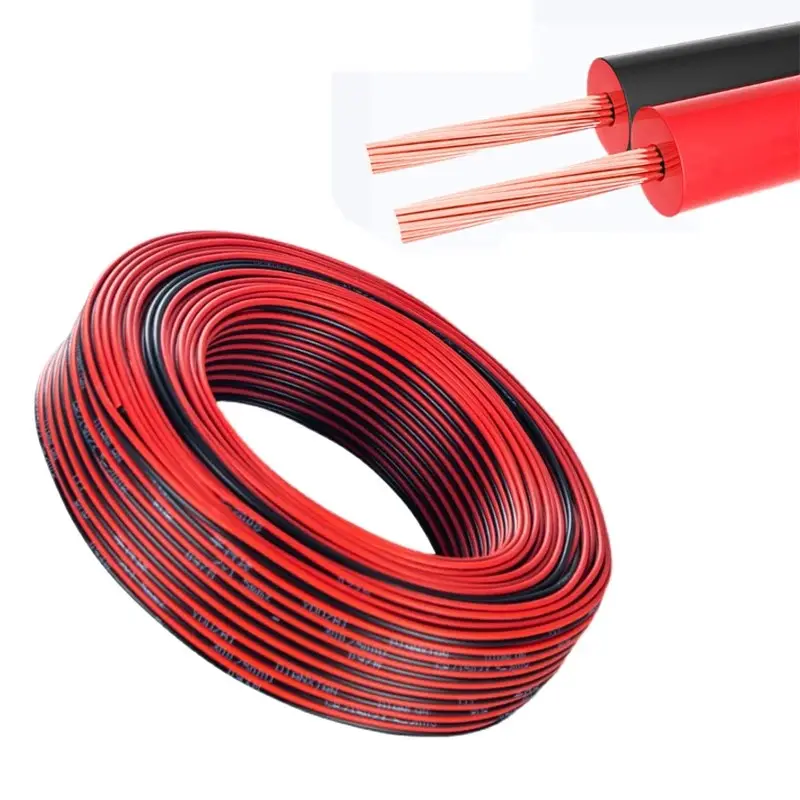
From light boxes to speakers, RVB silently connects every signal.
2025-08-18
RVB flat unsheathed flexible cable - lightweight, durable and cost-effective
🔌[In-Depth Analysis] What is RVB Cable? Real-World Examples Show You Where It's Used!
In everyday electrical installations, there's a seemingly common yet ubiquitous type of wire: RVB cable (copper-core PVC-insulated parallel flexible wire). Its name:
R: Flexible wire (multiple strands of fine copper wire, flexible and easy to bend)
V: PVC insulation
B: Parallel construction (two cores in parallel, not twisted)
Rated voltage is typically 300/500V. Flexible, lightweight, and low-cost, it's a hidden gem in many low-voltage wiring scenarios.

🔧 Real-World Application Examples:
Lighting Wiring: In LED ceiling and pendant light installations, RVB is often used for the internal connection between the lamp body and the junction box. The red/white two-color wire easily distinguishes the live and neutral wires, ensuring neat and efficient wiring.
In audio systems: In home theaters or public address systems, RVB is used to connect amplifiers and speakers (especially over short distances). While not professional audio cable, it performs reliably in projects with limited budgets. Internal Wiring in Control Boxes: Within distribution cabinets and automation control boxes, RVBs are used to connect signals between relays, indicator lights, and buttons, saving space and facilitating maintenance.
Home Appliance Repair: For internal wiring in older electric fans, desk lamps, electronic clocks, and other appliances, RVBs are often used to replace damaged original wiring, offering convenient installation.
✅ Advantages: Flexible, easy to install, low cost, and clearly distinguishable colors

⚠️ Note: Without an outer sheath, RVBs offer limited tensile strength and moisture resistance. It is recommended that they be installed in conduit or inside equipment to avoid exposure.
Although less well-known than RVV and BV cables, RVBs are indispensable in certain applications. Choose products that comply with the GB/T 5023 standard to ensure safety and longevity.
I. Overview
RVB cable is a common copper-core, PVC-insulated, parallel-connected flexible cable widely used for internal connections or power leads in household appliances, electronic equipment, lighting systems, and small power tools. The letters in the name "RVB" stand for:
- R: Flexible
- V: PVC Insulation
- B: Flat
The rated voltage is typically 300/500V or 450/750V, suitable for circuits with an AC frequency of 50Hz.
II. Structural Features
RVB cable utilizes a dual-core parallel structure, with two insulated conductors extruded side-by-side within a single PVC sheath, resulting in a flat profile. It has the following structural features:
1. Conductor: Made of multiple strands of fine, flexible copper wire, the annealed copper conductor offers excellent flexibility and fatigue resistance, making it suitable for applications subject to frequent bending or movement. 2. Insulation: Each conductor is covered with a layer of polyvinyl chloride (PVC) insulation, typically colored red/brown (live) and blue/black (neutral), to easily distinguish polarity.
3. Overall Construction: Two insulated cores are arranged in parallel, surrounded by a shared PVC sheath. The overall structure is a flat ribbon, with width greater than thickness, facilitating wiring and concealed installation.
This flat structure not only saves space but also offers a certain degree of pressure resistance and tangle resistance, making it suitable for wiring in confined spaces.
III. Material Composition
1. Conductor Material: Oxygen-Free Copper (OFC), with high purity and excellent conductivity. Annealed, it is flexible and easily bent, meeting the requirements of Class 5 conductors in the GB/T 3956 standard.
2. Insulation Material: Polyvinyl Chloride (PVC), which offers excellent electrical insulation, heat resistance (typically up to 70°C), flame retardancy, and chemical stability.
3. Jacket Material: Also made of PVC, providing mechanical and environmental protection. IV. Introduction to Flame Retardant Performance
The flame retardancy of RVB cables primarily depends on the PVC material formulation used for their insulation and sheathing. Standard RVB cables generally possess basic flame retardancy and comply with relevant national safety standards, as follows:
1. Self-Extinguishing
The PVC used in standard RVB cables contains chlorine, which releases chlorine free radicals when exposed to flames, inhibiting the combustion reaction and exhibiting self-extinguishing properties. This means that once the external fire source is removed, the cable will not continue to burn, thereby preventing the spread of fire.
2. Compliance with Flame Retardant Standards
Standard RVB cables generally meet the requirements of the single vertical flame test (IEC 60332-1) specified in GB/T 18380, "Electric and Optical Fiber Cables - Flame Tests Under Flame Conditions," and are classified as flame retardant grade ZRA (or standard flame retardant). 3. Optional Flame-Retardant Upgrade Models
- ZR-RVB: Based on the standard RVB, this cable utilizes flame-retardant PVC (ZR-PVC) for enhanced fire resistance. It is suitable for locations requiring high fire protection requirements, such as internal connections within distribution boxes and densely packed wiring environments.
- Some special models also offer low-smoke, zero-halogen (LSZH) RVBs. These cables emit low smoke and no toxic halogen gases during combustion, making them suitable for crowded or poorly ventilated locations (such as subways, tunnels, and data centers).
4. Limitations
- Standard RVB cables do not possess fire resistance (i.e., the ability to maintain power during a fire); they only prevent flames from spreading along the cable.
- Not recommended for open wiring in high-fire-risk areas or for trunk lines requiring fire inspections. For such applications, specialized flame-retardant or fire-resistant cables such as ZR-RVV and NH-RVS should be used. ---V. Application Scenarios
Due to its flexible, flat, and easy-to-lay features, RVB cable is widely used in the following areas:
1. Internal connections for household appliances: such as internal wiring in electric fans, rice cookers, vacuum cleaners, and audio equipment.
2. Lighting systems: Used for connecting lamps, especially in applications where concealed wiring is required, such as chandeliers and wall lamps.
3. Electronic instruments: Used as connecting cables for control circuits or signal transmission.
4. Small power tools: Power leads for handheld devices such as electric drills and saws.
5. Indoor wiring: Suitable for exposed or concealed power leads in dry environments, but not recommended for outdoor or humid environments.
VI. Advantages and Precautions
- Advantages:
- Flexible and easy to bend, making it easy to install;
- Flat design saves space and creates a neat and aesthetically pleasing appearance;
- Low cost and high cost-effectiveness;
- Excellent insulation performance and basic flame retardancy, providing high safety. - Precautions:
- Not suitable for use in environments with humidity, high temperatures, or corrosive gases;
- Prolonged exposure to sunlight may cause PVC to degrade;
- For outdoor use or in locations with high mechanical stress, select sheathed round cables (such as RVV);
- Avoid sharp bends during installation to prevent damage to the conductor or insulation;
- For locations with strict fire protection requirements, it is recommended to use ZR-RVB or higher flame-retardant/fire-resistant cables.
Relevant news
Quick Quote
* Note: Please be sure to fill in the information accurately and keep the communication open. We will get in touch with you as soon as possible

Copyright © 2023 Shandong Zhongmai Cable Co., Ltd

